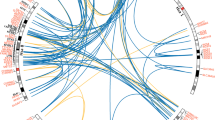Abstract
HOX genes encode transcriptional factors that play a pivotal role in specifying regional identity in nearly every bilateral animal. The birth of HOX gene cluster and its subsequent evolution, either in regulation or function, underlie the evolution of many bilaterian features and hence to the evolutionary radiation of this group. Despite of this importance, evolution of HOX cluster in vertebrates remains largely obscure because the phylogenetic history of these genes is poorly resolved. This has led to the controversy about whether four HOX clusters in human originated through two rounds (2R) of whole-genome duplications or instead evolved by small-scale events early in vertebrate evolution. Recently, the large-scale phylogenetic analysis of triplicate and quadruplicate paralogous regions residing on human HOX-bearing chromosomes provided an unprecedented insight into events that shaped vertebrate genome early in their history. Based on these data and comparative genomic analysis of fruit fly, red floor beetle, and human, this study infers the genic content of minimal HOX locus in the Urbilaterian and reconstructs its duplication history. It appears that four HOX clusters of humans are not remnants of polyploidy events in vertebrate ancestry. Rather, current evidence suggests that one-to-four transition in HOX cluster number occurred by three-step sequential process involving regional duplication events. Therefore, it is concluded that the evolutionary origin of vertebrate novelties, including the complexity of their body, is the consequence of small-scale genetic changes at widely different times over their history.



Similar content being viewed by others
References
Abbasi AA (2008) Are we degenerate tetraploids? More genomes, new facts. Biol Direct 3:50
Abbasi AA (2010a) Piecemeal or big bangs: correlating the vertebrate evolution with proposed models of gene expansion events. Nat Rev Genet 11:166
Abbasi AA (2010b) Unraveling ancient segmental duplication events in human genome by phylogenetic analysis of multigene families residing on HOX-cluster paralogons. Mol Phylogenet Evol 57:836–48
Abbasi AA, Grzeschik KH (2007) An insight into the phylogenetic history of HOX linked gene families in vertebrates. BMC Evol Biol 7:239
Ambreen S, Khalil F, Abbasi AA (2014) Integrating large-scale phylogenetic datasets to dissect the ancient evolutionary history of vertebrate genome. Mol Phylogenet Evol 78:1–13
Asrar Z, Haq F, Abbasi AA (2013) Fourfold paralogy regions on human HOX-bearing chromosomes: role of ancient segmental duplications in the evolution of vertebrate genome. Mol Phylogenet Evol 66:737–47
Bailey WJ, Kim J, Wagner GP et al (1997) Phylogenetic reconstruction of vertebrate Hox cluster duplications. Mol Biol Evol 14:843–53
Carroll SB (2001) Chance and necessity: the evolution of morphological complexity and diversity. Nature 409:1102–9
Durand D (2003) Vertebrate evolution: doubling and shuffling with a full deck. Trends Genet 19:2–5
Furlong RF, Holland PW (2002) Were vertebrates octoploid? Philos Trans R Soc Lond B Biol Sci 357:531–44
Hughes AL (2001) Evolution of the integrin alpha and beta protein families. J Mol Evol 52:63–72
Hughes AL, da Silva J, Friedman R (2001) Ancient genome duplications did not structure the human Hox-bearing chromosomes. Genome Res 11:771–80
Hughes AL, Friedman R (2003) 2R or not 2R: testing hypotheses of genome duplication in early vertebrates. J Struct Funct Genomics 3:85–93
Larhammar D, Lundin LG, Hallbook F (2002) The human Hox-bearing chromosome regions did arise by block or chromosome (or even genome) duplications. Genome Res 12:1910–20
Mora C, Tittensor DP, Adl S et al (2011) How many species are there on Earth and in the ocean? PLoS Biol 9:e1001127
Ohno, S., 1970. Evolution by gene duplication. Springer-Verlag.
Ohno S (1973) Ancient linkage groups and frozen accidents. Nature 244:259–62
Panopoulou G, Poustka AJ (2005) Timing and mechanism of ancient vertebrate genome duplications—the adventure of a hypothesis. Trends Genet 21:559–67
Parveen N, Masood A, Iftikhar N et al (2013) Comparative genomics using teleost fish helps to systematically identify target gene bodies of functionally defined human enhancers. BMC Genomics 14:122
Richards S, Gibbs RA, Weinstock GM et al (2008) The genome of the model beetle and pest Tribolium castaneum. Nature 452:949–55
True JR, Carroll SB (2002) Gene co-option in physiological and morphological evolution. Annu Rev Cell Dev Biol 18:53–80
Zhang J, Nei M (1996) Evolution of Antennapedia-class homeobox genes. Genetics 142:295–303
Acknowledgments
I am thankful to Faiqa Khalil (National Center for Bioinformatics, Quaid-i-Azam University, Islamabad) for helping me with Figures.
Authors’ contributions
AAA conceived the project and designed the experiments. AAA performed the experiments and analyzed the data. AAA wrote the paper.
Author information
Authors and Affiliations
Corresponding author
Additional information
Communicated by Volker G. Hartenstein
Rights and permissions
About this article
Cite this article
Abbasi, A.A. Diversification of four human HOX gene clusters by step-wise evolution rather than ancient whole-genome duplications. Dev Genes Evol 225, 353–357 (2015). https://doi.org/10.1007/s00427-015-0518-z
Received:
Accepted:
Published:
Issue Date:
DOI: https://doi.org/10.1007/s00427-015-0518-z




